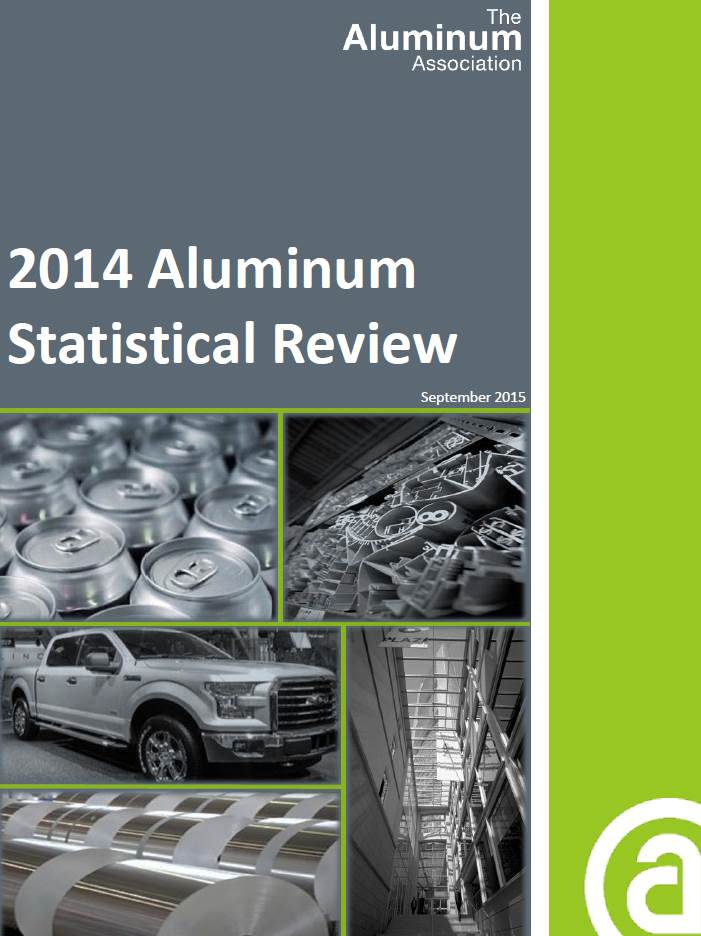
2014 Aluminum Statistical Review
Publisher: Aluminum Association
Reviewed by Ryan Olsen, Aluminum Association
The annual Aluminum Statistical Review is one of the industry’s longest-running and most essential publications. Published since the early 1960s, theStatistical Review provides a plethora of valuable industry data in one convenient package. In addition to a 20-page summary document highlighting top-level findings, readers also receive a suite of 18 detailed spreadsheets providing historical data on the industry reaching, in some cases, as far back as 1893.
Whether you’re interested in what the supply of aluminum looked like in the U.S. in 1942, or you’re curious what an aluminum can weighed in 1972, theStatistical Review has the answers. Perhaps you just want a sense of general industry trends over the past decade? It has that too. The 2015 edition of the Statistical Review, which includes statistics through 2014, assembles data on every aspect of the aluminum industry, including primary aluminum, secondary recovery, foreign trade, and shipments of mill products by form and end use market. While the latest edition focuses on the last ten years (2004-2014), the Statistical Review’s host of supplementary tables and charts also provide readers with a historical context upon which to compare current levels of activity in the North American aluminum industry.
Some noteworthy highlights and trends from the latest edition:
- Aluminum demand in North America experienced uninterrupted growth for a fifth consecutive year in 2014 (+3.6%) and has reached levels not experienced since the mid-2000s.
- The transportation sector represented the North American aluminum industry’s largest and fastest growing market. In 2014, shipments to that market increased 11.1% over 2013 and accounted for nearly 33% of the total demand.
- Net shipments of extruded products, including imports, to the North American market increased 7.5% over 2013. The two largest markets for extruded shapes, building and construction and transportation were up 8.3% and 11.0%, respectively.
- North American primary aluminum production totaled 4.6 million metric tons (10.1 billion lbs) in 2014, down 7.1 percent from a year earlier. U.S. primary production fell 12.2% year-over-year, while Canadian primary production was off 3.7% from 2013.
- Secondary recovery of aluminum accounted for roughly 35% of the total North American aluminum supply, while imports were responsible for nearly 20%.
- U.S. imports of aluminum and aluminum products increased 7.0% over 2013, to a total of 11.7 billion lbs. While Canada led the way with 6.6 billion lbs, imported aluminum from China increased more than 38% to 884 million lbs, more than 50% of which consisted of aluminum sheet.
The 2015 edition of the Statistical Review is divided into five major sections: Supply, Demand, Major Markets, Foreign Trade, and World Aluminum Statistics.
Supply: During 2014, the aluminum supply in North America totaled 25.5 billion lbs, increasing 3.6% over the 24.6 billion lbs recorded during 2013. Domestic U.S. and Canadian primary production decreased 7.1% to 10.1 billion lbs, while imports (excluding cross-border trade) of ingot and mill products increased 21.0% to 5.1 billion lbs. Recovery of aluminum from scrap declined 2.7% to an estimated 9.0 billion lbs.
Demand: Aluminum demand (producer net shipments plus imports) in North America increased 3.6% in 2014 to a total of 25.5 billion lbs. Flat rolled products, including foil, represented 43.3% of total shipments in 2014 (43.2% in 2013). Ingot for castings, destructive uses, and exports accounted for 30.9% (31.2% in 2013) and extrusions and tube shipments were 20.3% (19.6% in 2013) of total shipments.
Major Markets: During 2014, shipments of aluminum for transportation transportation related applications grew 11.1% to a volume of 8.4 billion lbs. The Containers and Packaging sector was the second largest market for aluminum in 2014 with a volume of 4.6 billion lbs, or 18.1% of total shipments. At 3.1 billion lbs, the Building and Construction sector grew 6.7% over the previous year, while Electrical market applications decreased 6.7% in 2014. Also in 2014, shipments to the Consumer Durable goods market and the non-electrical Machinery and Equipment market increased 6.8% and 6.0%, respectively.
Foreign Trade: U.S. imports of aluminum ingot and mill (semi-fabricated) products totaled 10.5 billion lbs in 2014, accounting for 46.8% of the U.S. aluminum supply. In contrast, U.S. exports of aluminum ingot and mill (semi-fabricated) products totaled 0.9 billion lbs and 2.8 billion lbs, respectively. While the U.S. is a net importer, Canada was a net exporter in 2014, with exports exceeding imports by 5.7 billion lbs.
World Aluminum Statistics: Estimated world production of primary aluminum totaled 53.2 million tonnes (117.2 billion lbs) in 2014, up 4.1% over the 2013 revised estimate of 51.1 million tonnes (112.7 billion lbs). Over the decade 2004-2014, world production increased at an annual growth rate of 5.4%. At 51.7%, China now accounts for over half of the world’s primary aluminum production. China’s estimated production in 2014 totaled 27.5 million tonnes (60.7 billion lbs), up 8.2% over their 2013 level. At 70.0 lbs per person, the U.S. ranked fifth in terms of apparent per capita consumption of aluminum in 2014. Canada, with 56.6 lbs per person, ranked tenth.
To purchase a download of the 2014 Aluminum Statistical Review, please visit the Aluminum Association “Bookstore” tab. The member price is $150 and the non-member price is $300.
Editor’s Note: The Aluminum Association represents U.S. and foreign-based companies and their suppliers throughout the value chain, from primary production to value-added products to recycling. The Association is the industry’s leading voice, providing global standards, business intelligence, sustainability research and industry expertise to member companies, policymakers, and the general public. The aluminum industry helps manufacturers produce sustainable and innovative products, including more fuel efficient vehicles, recyclable packaging, greener buildings and modern electronics. In the U.S., the aluminum industry creates $152 billion in economic activity.
This review was first published in the October 2015 issue of Light Metal Age.
